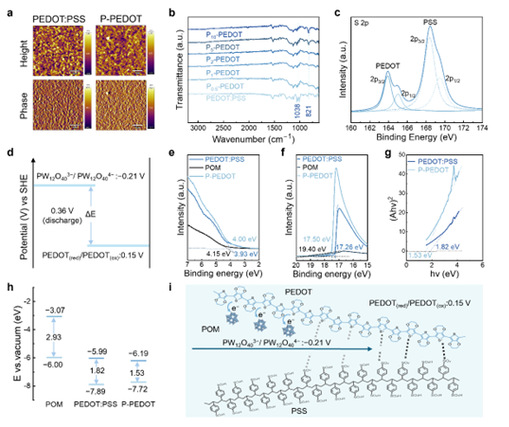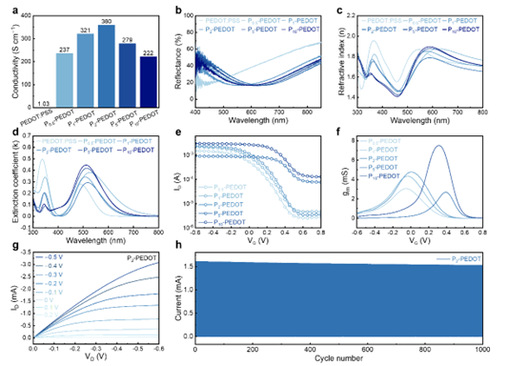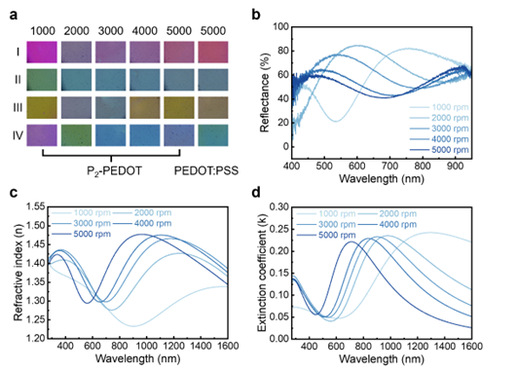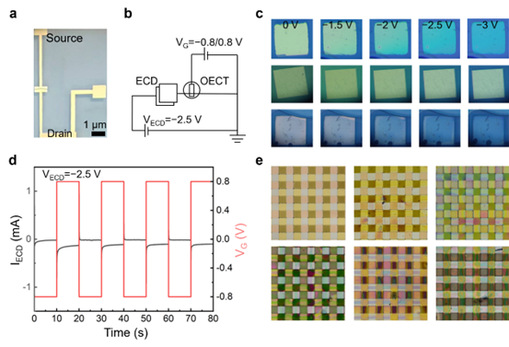Multi-color pixel displays have promising applications in the fields of adaptive camouflage, visual sensing, photonic computing, visual perception and spectral modulation. Enhancing light-matter interaction through electrochromic (EC) technology combined with Fabry-Pérot (FP) optical resonance to achieve multi-color modulation is a key technological direction to realize multi-color pixel display. Among them, poly(3,4-ethylenedioxythiophene):polystyrene sulfonate (PEDOT:PSS) has become the most promising electrochromic material by virtue of its high mechanical flexibility, excellent film-forming and fast response properties. However, the difficulty of traditional methods to regulate the optical dielectric properties of PEDOT in a simple and effective manner restricts the application of PEDOT on Fabry-Pérot resonance structures.
Recently, Wang Hongzhi / Li Kerui’s team at Donghua University developed a novel post-processing method for PEDOT:PSS, electrochemical auto-oxidative doping (EAOD) (Fig. 1), by introducing polymetallic oxides (POM) through a simple solution mixing and stirring, which significantly altered its optical-dielectric properties. The related research results were published in <Nano Letters> under the title ‘Liquid-Phase Electrochemically Autooxidized Dopingof PEDOT Enabling Fabry-Pérot Electrochromic Pixels’.

Fig. 1. Liquid-phase electrochemical autoxidation induced PEDOT:PSS simultaneous deep doping and phase separation

Fig. 2. Structure and energy level characterization of P-PEDOT
The liquid-phase EAOD method reduced the band gap of PEDOT, resulting in a significant increase in conductivity (from 1.03 to 360 S cm-1) and effective modulation of refractive index and extinction coefficient.

Fig. 3. Optoelectronic performance analysis of P-PEDOT
The resulting POM-doped self-oxidized PEDOT (P-PEDOT) significantly enhances the optical resonance of the Fabry-Perot cavity, extending the initial blue state of PEDOT to a wide range of colors.

Fig. 4. P-PEDOT-based multicolor film and optical properties
The multicolor modulation capability was demonstrated by a 100-pixel array. In addition, P-PEDOT-based organic electrochemical transistors (OECTs) achieved a 1000-fold switching ratio and maintained 94.4% stability after 1,000 cycles; the color change of the electrochromic array pixels (1 mm × 1 mm) can be controlled by a low gate voltage of only ±0.8 V.

Fig. 5. Demonstration of OECT-driven EC pixels and multicolor resonant cavity array
In summary, the team utilized a synergistic strategy of EAOD and phase separation to reduce the bandgap of PEDOT, thereby significantly improving its conductivity. It shows great potential for applications in EC display, biosensing, health monitoring and color display technology.
Link to full article: https://pubs.acs.org/doi/10.1021/acs.nanolett.5c00604
